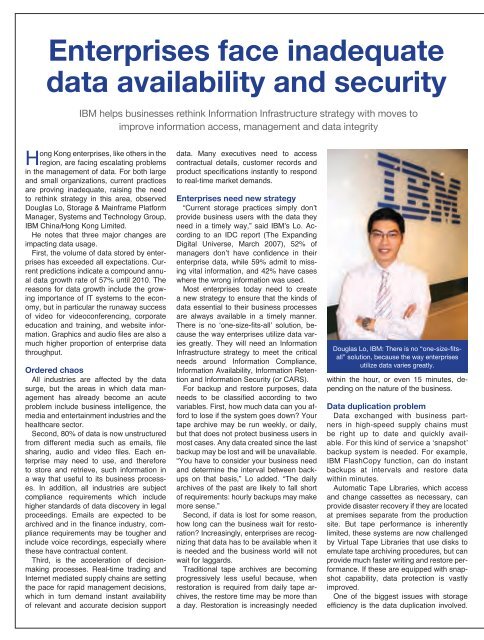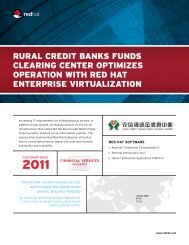Hong Kong Computer Society - enterpriseinnovation.net
Hong Kong Computer Society - enterpriseinnovation.net
Hong Kong Computer Society - enterpriseinnovation.net
You also want an ePaper? Increase the reach of your titles
YUMPU automatically turns print PDFs into web optimized ePapers that Google loves.
Enterprises face inadequate<br />
data availability and security<br />
IBM helps businesses rethink Information Infrastructure strategy with moves to<br />
improve information access, management and data integrity<br />
<strong>Hong</strong> <strong>Kong</strong> enterprises, like others in the<br />
region, are facing escalating problems<br />
in the management of data. For both large<br />
and small organizations, current practices<br />
are proving inadequate, raising the need<br />
to rethink strategy in this area, observed<br />
Douglas Lo, Storage & Mainframe Platform<br />
Manager, Systems and Technology Group,<br />
IBM China/<strong>Hong</strong> <strong>Kong</strong> Limited.<br />
He notes that three major changes are<br />
impacting data usage.<br />
First, the volume of data stored by enterprises<br />
has exceeded all expectations. Current<br />
predictions indicate a compound annual<br />
data growth rate of 57% until 2010. The<br />
reasons for data growth include the growing<br />
importance of IT systems to the economy,<br />
but in particular the runaway success<br />
of video for videoconferencing, corporate<br />
education and training, and website information.<br />
Graphics and audio files are also a<br />
much higher proportion of enterprise data<br />
throughput.<br />
data. Many executives need to access<br />
contractual details, customer records and<br />
product specifications instantly to respond<br />
to real-time market demands.<br />
Enterprises need new strategy<br />
“Current storage practices simply don’t<br />
provide business users with the data they<br />
need in a timely way,” said IBM’s Lo. According<br />
to an IDC report (The Expanding<br />
Digital Universe, March 2007), 52% of<br />
managers don’t have confidence in their<br />
enterprise data, while 59% admit to missing<br />
vital information, and 42% have cases<br />
where the wrong information was used.<br />
Most enterprises today need to create<br />
a new strategy to ensure that the kinds of<br />
data essential to their business processes<br />
are always available in a timely manner.<br />
There is no ‘one-size-fits-all’ solution, because<br />
the way enterprises utilize data varies<br />
greatly. They will need an Information<br />
Infrastructure strategy to meet the critical<br />
needs around Information Compliance,<br />
Information Availability, Information Retention<br />
and Information Security (or CARS).<br />
For backup and restore purposes, data<br />
needs to be classified according to two<br />
variables. First, how much data can you afford<br />
to lose if the system goes down? Your<br />
tape archive may be run weekly, or daily,<br />
but that does not protect business users in<br />
most cases. Any data created since the last<br />
backup may be lost and will be unavailable.<br />
“You have to consider your business need<br />
and determine the interval between backups<br />
on that basis,” Lo added. “The daily<br />
archives of the past are likely to fall short<br />
of requirements: hourly backups may make<br />
more sense.”<br />
Second, if data is lost for some reason,<br />
how long can the business wait for restoration?<br />
Increasingly, enterprises are recognizing<br />
that data has to be available when it<br />
is needed and the business world will not<br />
wait for laggards.<br />
Traditional tape archives are becoming<br />
progressively less useful because, when<br />
restoration is required from daily tape archives,<br />
the restore time may be more than<br />
Douglas Lo, IBM: There is no “one-size-fitsall”<br />
solution, because the way enterprises<br />
utilize data varies greatly.<br />
Ordered chaos<br />
All industries are affected by the data<br />
surge, but the areas in which data management<br />
within the hour, or even 15 minutes, depending<br />
on the nature of the business.<br />
has already become an acute<br />
problem include business intelligence, the<br />
media and entertainment industries and the<br />
healthcare sector.<br />
Second, 80% of data is now unstructured<br />
from different media such as emails, file<br />
sharing, audio and video files. Each enterprise<br />
may need to use, and therefore<br />
to store and retrieve, such information in<br />
a way that useful to its business processes.<br />
In addition, all industries are subject<br />
compliance requirements which include<br />
higher standards of data discovery in legal<br />
proceedings. Emails are expected to be<br />
archived and in the finance industry, compliance<br />
requirements may be tougher and<br />
include voice recordings, especially where<br />
these have contractual content.<br />
Third, is the acceleration of decisionmaking<br />
processes. Real-time trading and<br />
Inter<strong>net</strong> mediated supply chains are setting<br />
the pace for rapid management decisions,<br />
which in turn demand instant availability<br />
of relevant and accurate decision support a day. Restoration is increasingly needed<br />
Data duplication problem<br />
Data exchanged with business partners<br />
in high-speed supply chains must<br />
be right up to date and quickly available.<br />
For this kind of service a ‘snapshot’<br />
backup system is needed. For example,<br />
IBM FlashCopy function, can do instant<br />
backups at intervals and restore data<br />
within minutes.<br />
Automatic Tape Libraries, which access<br />
and change cassettes as necessary, can<br />
provide disaster recovery if they are located<br />
at premises separate from the production<br />
site. But tape performance is inherently<br />
limited, these systems are now challenged<br />
by Virtual Tape Libraries that use disks to<br />
emulate tape archiving procedures, but can<br />
provide much faster writing and restore performance.<br />
If these are equipped with snapshot<br />
capability, data protection is vastly<br />
improved.<br />
One of the biggest issues with storage<br />
efficiency is the data duplication involved.<br />
14 <strong>Computer</strong>world <strong>Hong</strong> <strong>Kong</strong> Nov 2009 www.cw.com.hk














